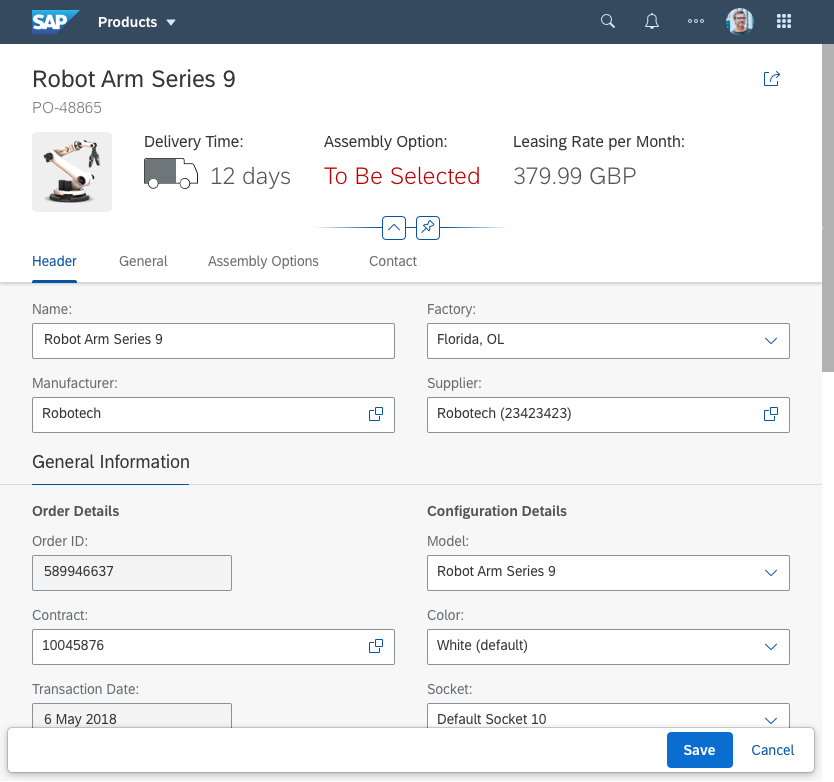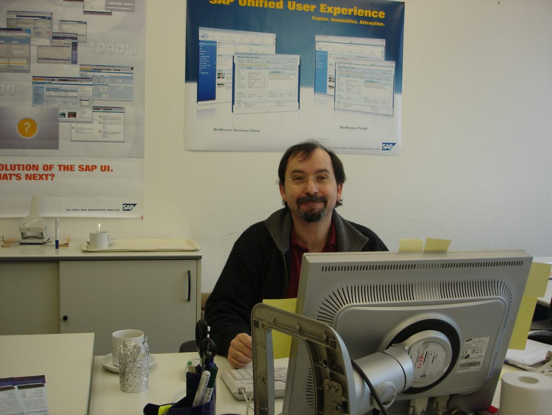
- SAP Community
- Groups
- Interest Groups
- Career Corner
- Blog Posts
- 6 Questions about 22 Years of User Research Expert...
- Subscribe to RSS Feed
- Mark as New
- Mark as Read
- Bookmark
- Subscribe
- Printer Friendly Page
- Report Inappropriate Content
Farewell to SAP User Research Expert Bernard Rummel
After 22 years at SAP, user research expert Bernard Rummel is retiring. How academic science, UserZoom, and submarines paved his career—and might pave yours—is part of my interview.
Bernard, superhero of user research, the one and only user research unicorn, Mr. UserZoom, MR. GDPR, or the guru for Excel and statistics are some of your nicknames. Which one do you like most?
Groundhog. It’s not on the list, but definitely groundhog (smiling). The nice thing about user research is that you can reuse a lot of your slides every five years!

Bernard Rummel – always on the lookout for positioning user research.
Alt text: Bernard is shown in a blue-white striped shirt, surrounded by bushes and blue sky. He is holding a hand above his eyes, peering into distance.
Hand on heart: Do academic sciences have a justified existence in the business context?
Definitely. Psychologist Kurt Lewin once said that there’s nothing more practical than a good theory. The reliability of insights and UX recommendations depend on setting up studies correctly, choosing the right metrics to measure, compare, and track user experience. I’m happy to have contributed to this with my work on analyzing task completion times in usability tests with so-called probability plots.
It’s a great example how seemingly abstract, quantitative methods from reliability and survival statistics can help you actually understand time data on a qualitative level. The method works not only for tests, but also for behavior tracking and analytics — any process that generates time data. The basic ideas are outlined in When Time Matters: It’s All About Survival!. A good practical introduction would be About Time: A Practitioner’s Guide to Task Completion Time Analysis in the Journal of Usability Studies.
Where has user research been going and what’s next?
The last few years were particularly important for user research at SAP, thanks to tools we at SAP Design introduced for recruiting and remote usability testing. While they seem to mostly support quantitative research, we learned how to use them to introduce qualitative research into the processes.
The starting point for this was a pilot study in 2016 about button placement in SAP Fiori. Following up on reports that the buttons were hard to find, we tested some variations of the design with UserZoom. The results of this study shaped today’s floating footer toolbar design.

Instead of the previous static button at the bottom of a page, the footer toolbar always appears as floating footer at the bottom of the screen.
Alt text: The screenshot shows an exemplary product in SAP Fiori, the Robot arm Series 9. Details of the products are displayed while the footer toolbar is floating at the bottom, providing the option to save or cancel.
Then, the breakthrough came around 2019 when the user experience insights solution UserZoom and the recruiting platform respondent were introduced to a wider audience at SAP (big kudos to my former colleague Jennifer Griese who made it happen with her relentless energy!). In an internal requirements analysis, we elaborated something we called the “Hierarchy of User Research Needs”.
Like in Maslow’s human needs hierarchy, each step depends on the ones below. First, you need access to research participants. The next thing teams need is quick feedback on designs. Once this is covered, you can engage in more proactive and strategic research—and find an interested audience in your design and development teams. Respondent gave us quick access to end users, and UserZoom lets us run studies with them and extend the study scope easily, all within days. Suddenly, limited time and resources for upfront user research were no longer showstoppers. Remote testing and recruiting saves budget and time, design decisions can be informed with data within days: Research already is a natural part of agile development—and will be way more in the future with the help of constant technological progress.

Hierarchy of needs for user research in ascending order. 1. Access to end users 2. Quick feedback on designs. 3. Upfront-info about people, flow, and structure. 4. Strategic info.
Alt text: The hierarchy is visualized by blue stairs, varying from light to dark.
The recent developments in user research will definitely also play a big role in the future. There is a big data source being tapped, and done right, it will raise more questions than it answers. The entire user research food chain will benefit from this, and with this, eventually, SAP.
How has your passion for user experience research started?
I have an academic background in experimental and engineering psychology as well as systemic consulting. In 1990, I started to work for the Naval Institute of Maritime Medicine in Kiel, Germany. Some of my main tasks included evaluating workstations and maritime safety equipment, critical incident intervention, and research in naval psychology. I came into software ergonomics via control stations in surveillance planes, ships, and submarines. Driving a submarine can be unspeakably boring, but the technical and UI aspect is fascinating.
Then, as chance would have it, on a bus on our way to a UX conference, I met a guy who carried one of SAP’s famous conference bags. It was Udo Arend, one of the godfathers of UX design at SAP, and co-author of a popular German book on software ergonomics. The rest is history. But jokes aside, when I started at SAP back in 2000, I was impressed by the strong founding spirit at SAP. Coming from German civil service, I couldn’t believe how motivated you can be by great teamwork. It felt like a jet pack!

You can tell the hardware ergonomist by the flipped monitor stand, bringing it to a decent viewing angle. (2008)
Alt text: The picture shows Bernard sitting at his desk in the SAP office.
The possibilities of user research excite me until today. Our team’s involvement in designing the German Corona-Warn-App is a great example: Only because of the flexibility of remote research, we could recruit and test with hundreds of end users within days, sometimes hours. We literally tested ourselves into the hearts of the team, and gradually could tackle more and more qualitative questions.
What was your role in shaping user research at SAP and for our customers?
I started working for Enjoy SAP, the first major UX initiative for SAP R/3 back then. Much of its design concepts are still alive in today’s SAP Fiori launchpad. One Monday morning, someone had the spontaneous idea to run a usability test on it. Within the following week, we managed to recruit participants, write tasks, test, and present results. This legendary project proved that user research doesn’t have to be a bottleneck for a large company.
Another turning point for user research at SAP was in 2011. The business software industry had discovered summative usability testing, SAP followed, and I switched positions to user research. The focus was on benchmarking to generate usability KPIs of our applications. I had always been keen on running a usability lab, and now I had the chance on SAP’s campus in Walldorf, which probably is, by the way, the oldest, in continuous use existing usability lab in Germany! During this high time of usability testing, a lot of methodological knowledge was being generated, for example standardized procedures, assist policies, and metrics.
As one highlight, a team of researchers including myself was sent to the SAP office in Chicago to test mobile apps for truck drivers. We weren’t sure at all what to expect from them in terms of tech literacy and phones they’d use. Turned out they all had top-notch smartphones, and with one I ended up discussing classical music. You’re always in for surprises with end users!
The incredibly rich data set from this campaign helped me investigate interesting methods. For instance, the magnitude estimation technique: participants are asked to rate usability in comparison to three reference applications. It has a mixed reputation because of statistical distribution issues, which I could resolve. This is how I got into UX metrics—it’s a passion, some would say.
Having shaped the SAP user research community from the beginning, what advice would you like to share?
User research is a great trade but a hard sale. I went into Human-Computer Interaction because the human side of things never changes. The flip side of this is that human engineers don’t change either, so you need to constantly push the user perspective on the radar of development organizations. I guess this won’t ever change in technology history, but it stays interesting, just as Albert Camus said: "One must imagine Sisyphus happy." Well, with our recent focus on research tools and operations, at least we gave him a really good wheelbarrow.
On a more personal level, I’d say, be curious and spread the research mindset—stay open to surprises. However, respect users’ rights, such as the General Data Protection Regulation (GDPR). And organize your presentations well. You’ll be happy to find them again in five years, Sisyphus.
Bernard, thank you so much. We wish you many adventures ahead – you will be missed!
Experience and people matter. Follow our journey as we transform the way we build products for enterprise on www.sap.com/design .
- SAP Managed Tags:
- User Experience,
- Careers,
- Research and Development
You must be a registered user to add a comment. If you've already registered, sign in. Otherwise, register and sign in.
| User | Count |
|---|---|
| 13 | |
| 12 | |
| 2 | |
| 1 | |
| 1 |